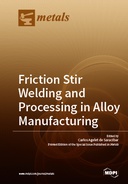Explore

Friction Stir Welding and Processing in Alloy Manufacturing
0 Ungluers have
Faved this Work
Login to Fave
Friction stir welding (FSW) is considered to be the most significant development in metal joining in decades and, in addition, is a ""green"" technology due to its energy efficiency, environmental friendliness, and versatility. This process offers a number of advantages over conventional joining processes. Furthermore, because welding occurs via the deformation of material at temperatures below the melting temperature, many problems commonly associated with joining of dissimilar alloys can be avoided, and thus, high-quality welds are produced. Due to this fact, FSW has been widely used in different industrial applications where metallurgical characteristics should be retained, such as in the aeronautic, naval, and automotive industries.
This book is included in DOAB.
Why read this book? Have your say.
You must be logged in to comment.
Rights Information
Are you the author or publisher of this work? If so, you can claim it as yours by registering as an Unglue.it rights holder.Downloads
This work has been downloaded 161 times via unglue.it ebook links.
- 31 - pdf (CC BY-NC-ND) at Unglue.it.
Keywords
- abnormal grain growth
- adaptive control
- Al/Fe dissimilar joining
- aluminum alloy
- deflection compensation control
- dissimilar joints
- dissimilar metal welding
- dissimilar welded joints
- Fe-containing constituents
- force–deflection model
- Friction
- friction stir processing
- friction stir spot welding
- friction stir welding
- friction-stir welding
- FSW
- FSW process
- grain orientation
- high nitrogen steel
- high rotation speed friction stir welding
- high-temperature softening materials
- intermetallic compounds
- lognormal distribution
- material flow
- material orientation
- materials position
- mechanical behaviour
- Mechanical properties
- mechanical strength
- Microstructure
- microstructure analysis
- n/a
- non-equilibrium segregation
- offset position control
- particle distribution
- pin shapes
- plunge depth
- plunge depth control
- post-weld heat treatment
- process analysis
- Stainless Steel
- surface composites
- the rotational speeds
- thema EDItEUR::P Mathematics and Science::PN Chemistry
- tilt angle
- Vickers microhardness
Links
DOI: 10.3390/books978-3-03921-208-8Editions


